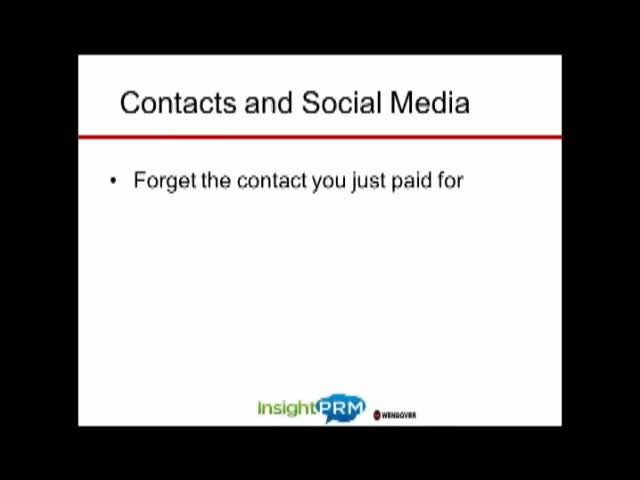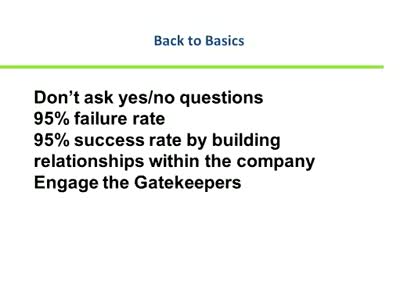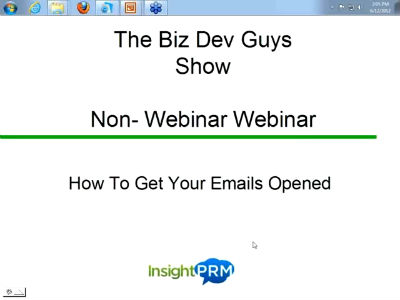B2B Engagement Marketing
Engagement Marketing Can Change the Way You Sell!
by Larry Dillon, CEO
Engagement marketing has become a critical tool in helping companies magnify their sales. At InsightPRM, we have seen companies grow from a few hundred clients to over 500,000 in less than 10 years using these simple techniques. What is engagement marketing? Let me answer that in a roundabout way. We recently surveyed 1000 businesses in North America and Europe—everything from banking to IT Services. We asked them to state the value most important to buyers today. The number 2 response was Price, but the number 1 response was Trust—maybe not so surprising in today’s information-packed marketplace. In an age when you can find out everything you need to know about a company in a few minutes online, trust may be hard to establish and easy to lose.
Building trust may therefore be the most significant cornerstone of modern marketing and sales. Are the most successful companies today asking, “How can we help our clients?” or are they wondering, “How can we make more money?” As focuses shift, opportunities to build trust may be lost. If you are not surprising, amazing and delighting your customers and prospects, your competitors might be. Why not build trust by offering something of value to your prospects for free? By providing useful information, you can save your prospects time and money, assist them in growing their business, or help them to avoid typical mistakes that companies make when purchasing or deploying your services. It’s a very old-school approach to engage prospects by starting the conversation with, “I would like a few moments of your time to talk about our services.” Why not captivate the client by offering valuable information free of charge?
If you have a marketing campaign with a 2% to 7% response rate, that’s great. An email campaign with a 10% click-through rate is outstanding. Even in effective cold-calling campaigns, a 15% response rate is considered excellent. The bottom line, however, is that about 90% of your lead-generating efforts are unsuccessful. Even worse, many companies struggle to convert leads into opportunities after they have been generated. In fact, most companies have difficulties managing their prospects across multiple platforms, from traditional marketing to web responses.
Recently, The Harvard Business Review published a study indicating that consumers are 7 times more likely to engage with a key decision maker if they receive a response to initial enquiries within an hour. Only 36% of companies achieve this critical response time. MIT (Massachusetts Institute of Technology) released a study indicating that if you respond to a web request more than an hour after you receive the inquiry, the probability of closing the deal declines by over 50%. Our observation in the cold calling arena is that only 1 in 5 inside sales reps are effective. Don’t believe us? If 80% of your sales are from 20% of your sales team, you’re likely missing out on key opportunities. Engagement marketing serves as a strategy to help customers reverse this 90% failure rate.
How does Engagement Marketing work?
Let’s say you have a list of prospects, suspects, or leads that have a high probability of needing your services in the next 4 to 24 months. (If someone needs your services in less than 4 months, you should have been on the phone to schedule an appointment yesterday.) The key to engagement marketing is to find prospects in that crucial stage before they turn to the internet, before they start seriously looking for bids.
The typical approach to prospecting mid-range and long-term leads is to call and ask questions to determine if potential customers have need, a time frame, and a budget. This has worked well since the beginning of time, and it still does, but the problem with this approach is that it is quickly perceived as a sales call. Some people will quickly dismiss a sales call by claiming they are not in the market or they are not interested, even if this isn’t true. Don’t assume that they won’t be buying what you sell within the next couple of quarters. I’ve clocked millions of dollars in deals that our clients have closed from this prospect group. In many cases, our clients have called us and said, “I called this prospect every 4 weeks for three months, but each time, they said they were not interested in our services. On the fifth follow up, the prospect finally said, ‘We are interested; we do need your services.’”
Buyers don’t have to tell you the truth. They are busy, and the probability of you calling them at exactly the right time is slim. Research shows that 80% of sales people will give up after the first no. In fact, in a 2010 study, we took 475 disqualified leads from our clients, reconfirmed them, and discovered that 75% were actually qualified leads. Why would a prospect give a false answer to a sales rep? One reason is that most people don’t enjoy being sold to. As a buyer, wouldn’t it be nice every now and then to be offered something for free instead of receiving a sales pitch? By engaging your buyer, you can turn that negative answer into a confirmed prospect.
How do I engage?
First, keep in mind that engagement is not a replacement for inside sales. Selling Power Magazine reported in 2012 that while outside sales are increasing by 1% this year, inside sales are increasing by 7%, proving the effectiveness of this strategy. Engagement marketing is intended to be used in addition to your other proven sales and marketing efforts. Take the list of companies that are likely to need your services in the next 4 to 24 months. Why not reach out to this group through email and a telephone campaign? You could set up a networking event at your offices or the local office of a manufacturer that you work with. If you do a lot of business with, say, CNPP manufacturers, they’d likely be happy to host your function in their offices. Go to Costco, get a few cases of soda, Danish, and coffee, and you can set up the whole event for less than $500.00. What’s the purpose of the event? Providing your prospects with valuable information for free.
If you compare a sales cold call with a cold call that invites prospects to a free event, you can see how engagement marketing really makes a difference in your approach. Which call is more appealing to you?
Hi, my name is Bob, and I am from XYZ Network Solutions. We are the largest and fastest growing MSP in the metro area. I wanted to ask you some questions about your network to understand how we might help you.
OR
Hi Frank, my name is Bob. First, this is not a sales call. I am with XYZ Network Solutions, and our CEO, Tim Wiley, has asked me to invite you to a special event we are having at the local offices of CNPP. I promise that no one will try to sell you anything. Tim is going to give a talk on how to leverage your IT systems to reduce your overall spend and increase productivity. After that, there is going to be a networking event with refreshments. There will be many other businesses from the area, and it should be a productive and fun event.
Imagine how hosting a few such events each year can help you build good will and trust! If your prospects are in the market for your services down the road, they’re much more likely to call you after attending one or more of your events. If your sales team contacts a prospect after you have invited them to your events, they will likely be much more receptive to the call. The best part is that your customers will spread the word, and you will likely receive plenty of referrals.
Does this tactic work? One company that employs this strategy has 29 people across the country hosting events 3 to 5 times per week. In about 10 years, they have experienced tremendous growth, rocketing from a few hundred customers to over 500,000.
What if your prospect can’t make it to any of your events? You still have the option of sending them free, valuable information or otherwise demonstrating to the prospect that you are interested in them. This allows you to instill a very positive image of your company, building trust with every phone call or invitation. Since free information or an invitation to a networking event would hardly be viewed as negative or even neutral, every phone call benefits your company. The bottom line: you can flip the10% success rate of traditional marketing to the 90% success rate of B2B Engagement Marketing.
All content is property of Wendover Corporation and may not be reproduced without written consent.









